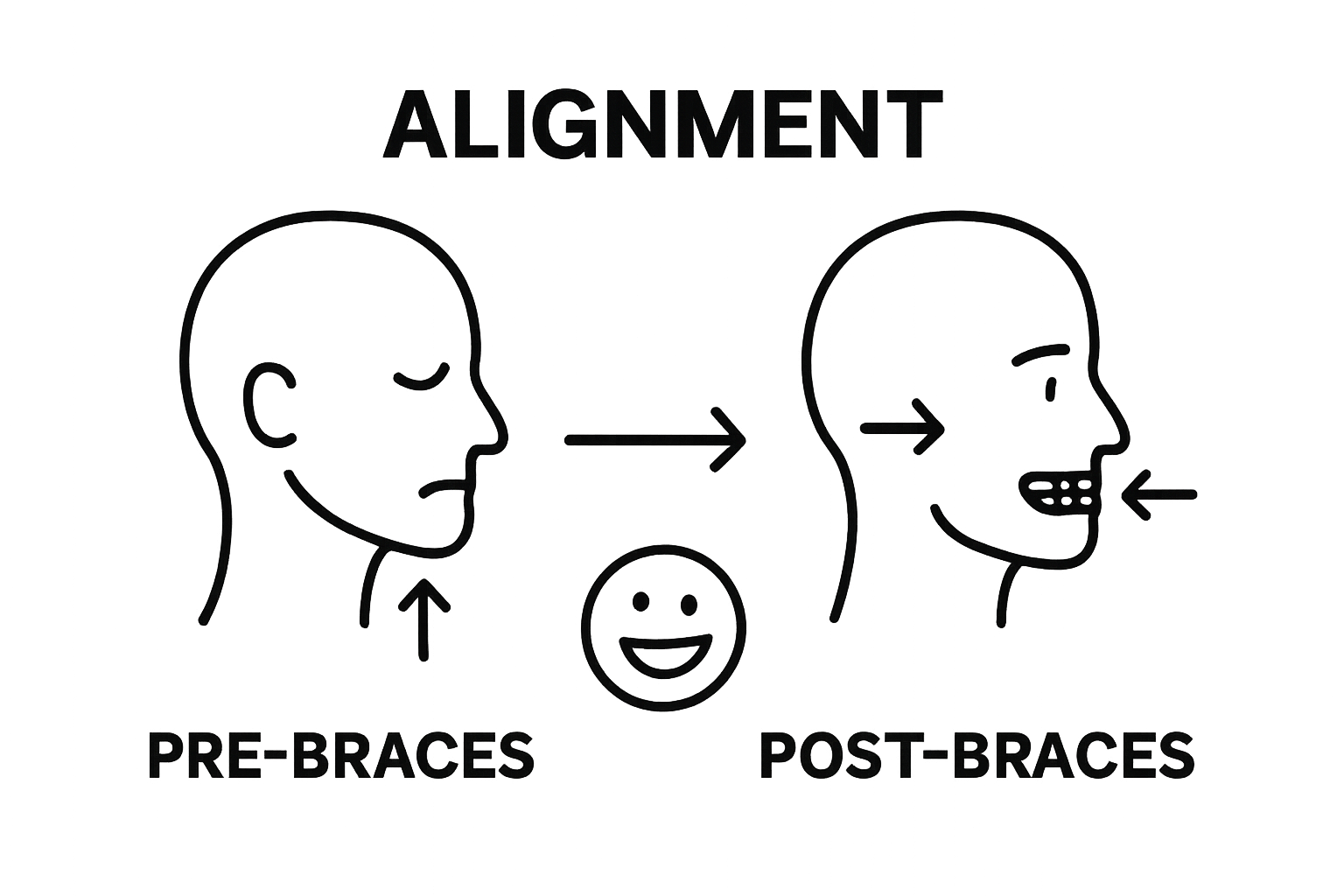Will Braces Change My Face? Understanding the Impact
September 16, 2025
Will Braces Change My Face? Understanding the Impact
Braces do more than just straighten crooked teeth and fix an overbite. They can actually reshape your entire face, not just your smile. In fact, studies reveal that orthodontic treatments can significantly alter facial soft tissue and symmetry over time. While most people expect cosmetic tweaks, the real surprise is how much braces can influence your profile, jawline, and even confidence. The most fascinating part? These changes happen gradually and often look more natural than you might ever guess.
Table of Contents
- How Braces Affect Facial Structure And Appearances
- Understanding The Science Behind Orthodontic Changes
- Why Facial Changes Matter For Confidence And Health
- The Role Of Age In Orthodontic Transformations
- Exploring Different Types Of Braces And Their Effects
Quick Summary
| Takeaway | Explanation |
|---|---|
| Braces improve facial symmetry | Orthodontic treatment realigns teeth and jaw, enhancing overall facial proportions. |
| Soft tissues adapt during treatment | As teeth move, lips and cheeks adjust, creating natural facial enhancements. |
| Age affects orthodontic outcomes | Younger patients typically experience faster, more predictable results compared to adults. |
| Different braces serve unique needs | Options like metal, ceramic, and aligners offer various aesthetics and functionalities. |
| Braces impact confidence and health | Improved facial aesthetics can boost self-esteem and prevent dental complications. |
How Braces Affect Facial Structure and Appearances
Orthodontic treatments do far more than straighten teeth. They can fundamentally transform your facial aesthetics by strategically repositioning bones, muscles, and soft tissues. Understanding how braces modify facial structure helps patients set realistic expectations about their treatment outcomes.
Bone Repositioning and Facial Symmetry
Braces work by applying consistent, gentle pressure to teeth and underlying bone structures. This pressure gradually shifts teeth and can influence jaw alignment, which directly impacts facial symmetry. According to BMC Oral Health research, orthodontic interventions can significantly alter facial soft tissue, particularly in the perioral region.
Key facial changes might include:
- Improved jaw alignment
- Balanced facial proportions
- Enhanced profile symmetry

- Reduced protrusion of upper or lower jaw
Soft Tissue Adaptation and Muscular Changes
As teeth and bones move, surrounding soft tissues and muscles adapt to new positions. This adaptation can create subtle but noticeable changes in facial appearance. Patients often experience modifications in:
- Lip positioning and fullness
- Cheek contours
- Overall facial muscle tension
- Smile dynamics
These transformations occur gradually, allowing natural-looking adjustments that enhance individual facial characteristics rather than creating an artificial appearance.
Long-Term Aesthetic Impacts
Orthodontic treatments provide more than temporary cosmetic improvements. By correcting fundamental structural issues, braces can create lasting changes in facial aesthetics. Deep learning simulations demonstrate that planned craniomaxillofacial movements can produce significant and permanent facial appearance modifications.
Patients should understand that while braces can dramatically improve facial symmetry and proportions, results vary based on individual anatomical structures and specific orthodontic challenges. Consulting with a professional orthodontist helps set accurate expectations about potential facial transformations.
Understanding the Science Behind Orthodontic Changes
Orthodontic treatments represent a sophisticated biological process of strategic tissue manipulation and bone remodeling. The science behind braces involves complex biomechanical principles that transform dental and facial structures through precisely calculated mechanical forces.
Biomechanical Forces and Cellular Response
Orthodontic movement occurs through a carefully controlled process of mechanical stress and biological adaptation. When braces apply consistent pressure to teeth, they trigger a remarkable cellular response within the periodontal ligament and surrounding bone tissues. According to research published in the National Institutes of Health, these mechanical forces initiate a cascade of biological reactions that enable tooth movement.
Key mechanisms of orthodontic movement include:
- Bone resorption on pressure sites
- Bone formation on tension sites
- Cellular recruitment and remodeling
- Gradual tissue adaptation
Physiological Remodeling Processes
The human body responds to orthodontic pressure through intricate physiological remodeling. Osteoclasts break down bone tissue on the pressure side of a tooth, while osteoblasts simultaneously build new bone on the tension side. This synchronized process allows teeth to move gradually and permanently without compromising structural integrity.
Critical factors influencing orthodontic movement include:
- Individual biological response
- Age and hormonal conditions
- Bone density
- Overall health status
Biomechanical Principles in Treatment Design
Orthodontists leverage advanced biomechanical principles to design personalized treatment strategies. By understanding individual variations in bone density, tissue elasticity, and cellular response, they can create precise treatment plans that guide teeth into optimal positions.
Modern orthodontic science combines mechanical engineering, biology, and patient-specific analysis to achieve predictable and stable dental alignments. The goal extends beyond mere aesthetic improvement to functional restructuring of dental and facial anatomy.
Why Facial Changes Matter for Confidence and Health
Orthodontic treatments extend far beyond physical adjustments, profoundly impacting psychological well-being and social interactions. The relationship between facial appearance and personal confidence is deeply interconnected, with subtle changes in facial structure potentially transforming an individual’s self-perception and emotional experiences.
Psychological Impact of Facial Aesthetics
Facial appearance plays a crucial role in how individuals perceive themselves and how others perceive them. According to research published in the Journal of Orofacial Orthopedics, orthodontic treatments that improve facial aesthetics can lead to significant psychological benefits. These improvements often translate into enhanced self-esteem and social confidence.
Key psychological benefits include:
- Increased self-confidence
- Reduced social anxiety
- Improved emotional well-being
- Enhanced personal and professional interactions
Social Perception and Personal Identity
Facial symmetry and proportion are subconsciously associated with attractiveness and health. Orthodontic treatments that create more balanced facial features can help individuals feel more comfortable in social settings. The subtle improvements in facial structure can shift how people perceive themselves, leading to more positive self-image and increased willingness to engage in social interactions.
Factors influencing social perception include:
- Facial symmetry
- Smile aesthetics
- Jaw alignment
- Overall facial harmony
Long-Term Emotional and Health Implications
Beyond immediate aesthetic improvements, orthodontic treatments can address functional issues that impact overall health. Correcting misalignments can improve breathing, reduce jaw pain, and prevent potential dental complications. These functional improvements contribute to both physical and mental well-being.
The holistic benefits of orthodontic treatments demonstrate that facial changes are not merely cosmetic but integral to an individual’s comprehensive health and quality of life.
 By addressing both physical and psychological aspects, orthodontic interventions offer a transformative approach to personal wellness.
By addressing both physical and psychological aspects, orthodontic interventions offer a transformative approach to personal wellness.
The Role of Age in Orthodontic Transformations
Age plays a critical role in determining the effectiveness, complexity, and potential outcomes of orthodontic treatments. From biological responsiveness to tissue regeneration, an individual’s age significantly influences how teeth and facial structures respond to orthodontic interventions.
Biological Responsiveness and Treatment Dynamics
Younger patients typically experience more rapid and predictable orthodontic transformations due to higher cellular metabolism and tissue plasticity. According to research in Progress in Orthodontics, teenagers generally achieve more consistent tooth movements compared to adults, highlighting the biological advantages of early intervention.
Key age-related treatment considerations include:
- Higher cellular regeneration rates in younger patients
- More flexible bone remodeling capabilities
- Faster healing and adaptation processes
- Greater treatment predictability
Developmental Stage and Orthodontic Complexity
The developmental stage of teeth and jaw structures directly impacts treatment approaches. Different age groups present unique orthodontic challenges and opportunities. Dental age reflects not just chronological years but the specific developmental stage of an individual’s oral structures.
Critical developmental factors include:
- Tooth eruption patterns
- Jaw growth potential
- Skeletal maturity
- Hormonal influences on tissue response
Long-Term Treatment Outcomes
While age influences initial treatment responsiveness, orthodontic interventions can be successful across different life stages. Adults may experience slower tissue adaptation but can still achieve significant aesthetic and functional improvements. The key lies in personalized treatment planning that considers individual biological characteristics.
Modern orthodontic science recognizes that age is not a limitation but a critical factor in designing targeted, effective treatment strategies. By understanding the intricate relationship between age and biological processes, orthodontists can optimize interventions for patients of all ages.
Exploring Different Types of Braces and Their Effects
Orthodontic technology has evolved significantly, offering patients multiple brace options tailored to individual needs, aesthetic preferences, and treatment complexities. Understanding the unique characteristics and impacts of different brace types empowers patients to make informed decisions about their orthodontic journey.
Traditional Metal Braces: The Reliable Classic
Traditional metal braces represent the most recognizable and time-tested orthodontic solution. Constructed from high-grade stainless steel, these braces use metal brackets and wires to apply consistent pressure and gradually reposition teeth. According to contemporary orthodontic research, metal braces remain highly effective for complex dental misalignments.
Key characteristics of metal braces include:
- Maximum treatment control
- Most cost-effective option
- Suitable for complex dental corrections
- Strongest mechanical pressure application
- Shortest average treatment duration
Ceramic and Clear Braces: Aesthetic Alternatives
Ceramic and clear braces offer patients a more discreet orthodontic experience. These alternatives utilize tooth-colored or transparent brackets that blend seamlessly with natural tooth enamel, providing a less noticeable treatment option. While aesthetically superior, they function similarly to traditional metal braces but require more meticulous maintenance.
Unique features of ceramic and clear braces:
- Enhanced aesthetic appeal
- Less visible than metal braces
- Similar mechanical effectiveness
- Slightly higher treatment cost
- Potential for slightly longer treatment times
Advanced Alignment Technologies
Modern orthodontics introduces innovative solutions like clear aligners and lingual braces, which offer unprecedented customization and discretion. These technologies leverage advanced digital scanning and 3D modeling to create personalized treatment plans that minimize visual intrusion while maximizing dental correction precision.
Innovative alignment technologies prioritize patient comfort, aesthetic preferences, and precise dental repositioning. By offering multiple brace types, orthodontists can design treatment strategies that address not just dental alignment but individual patient needs and lifestyle considerations.
Here is a comparison of the main types of braces discussed in the article, showing their unique features, advantages, and considerations for patients who are evaluating their options:
| Type of Braces | Visibility | Cost | Strength/Effectiveness | Suitable for Complex Cases | Treatment Duration |
|---|---|---|---|---|---|
| Traditional Metal Braces | Most visible | Most affordable | Strongest mechanical control | Yes | Shortest on average |
| Ceramic/Clear Braces | Less visible | Slightly higher | Comparable to metal with more maintenance | Yes | May be slightly longer |
| Advanced Aligners/Lingual | Nearly invisible | Highest | Highly customized, precise | Some complex cases (not all) | Varies by case |
Ready to See the True Impact of Braces on Your Face?
Are you wondering how braces might change your confidence, your smile, or even your entire facial structure? Many people worry about facial symmetry, jaw alignment, and the way orthodontic treatment shapes their appearance. At Glow Orthodontics, we understand that the journey to a glowing smile is deeply personal. We specialize in transforming not just your teeth but your overall facial harmony through tailored orthodontic care. Our team uses the latest techniques to guide every aspect of your treatment from the first consultation to your radiant results. If you want to experience expert care in a warm, supportive environment, learn how we can help you achieve your goals at Glow Orthodontics.

Curious about what your transformation could look like? Take the next step for yourself. Meet our friendly team, explore real patient experiences, and book your personalized consultation today. Your healthiest smile and newfound confidence are just one decision away.
Frequently Asked Questions
Will braces change my facial structure?
Yes, braces can change your facial structure by improving jaw alignment and enhancing facial symmetry. The repositioning of teeth and underlying bone structures can lead to noticeable changes in facial aesthetics.
How do braces impact facial symmetry?
Braces apply consistent pressure to teeth, which can influence jaw alignment and subsequently affect facial symmetry. Many patients experience balanced facial proportions as a result of orthodontic treatment.
What are the long-term effects of wearing braces on facial appearance?
Long-term effects of braces can include improved jaw alignment, balanced facial features, and lasting changes in facial aesthetics. Treatment can foster lasting beneficial modifications, which contributes to overall self-confidence.
Do different types of braces have different impacts on facial changes?
Generally, all types of braces aim to align teeth and improve facial aesthetics; however, traditional metal braces tend to provide maximum control over complex dental corrections, while ceramic and clear braces are more discreet and may have slight variations in treatment duration.